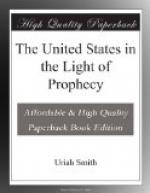The next symbol to engage our attention is the leopard beast of chapter 13, to which the dragon gives his seat, his power, and great authority. It would be sufficient on this point to show to what power the dragon, Pagan Rome, transferred its seat and gave its power. The seat of any government is certainly its capital city. The city of Rome was the dragon’s seat. But in A.D. 330, Constantine transferred the seat of empire from Rome to Constantinople; and Rome was given up to what? To decay, desolation, and ruin? No; but to become far more celebrated than it had ever before been, not as the seat of pagan emperors, but as the city of St. Peter’s successors, the seat of a spiritual hierarchy which was not only to become more powerful than any secular prince, but through the magic of its fatal sorcery was to exercise dominion over the kings of the earth. Thus was Rome given to the papacy; and the decree of Justinian, issued in 533, and carried into effect in 538, constituting the pope the head of all the churches and the corrector of heretics, was the investing of the papacy with that power and authority which the prophet foresaw.
It is very evident, therefore, that this leopard beast is a symbol of the papacy. But there are other considerations which prove this. This beast has the body of a leopard, the mouth of a lion, and the feet of a bear, which shows it to be some power which succeeded those three beasts of Daniel’s prophecy, and retained some of the characteristics of them all; and that was Rome. But this is not the first, or pagan form of the Roman government; for that is represented by the dragon; and this is the form which succeeded that, which was the papal.
But what most clearly shows that this beast represents the papacy, is its identity with the little horn of the fourth beast of Daniel 7, which all Protestants agree in applying to the papal power.
1. Their chronology. The little horn arises after the great and terrible beast, which represents Rome in its first or pagan form, is fully developed even to the existence of the ten horns, or the division of the Roman empire into ten parts. Dan. 7:24. The leopard beast succeeds the dragon which also represents Rome in its pagan form. These powers appear therefore upon the stage of action at the same time.
2. Their location. The little horn plucked up three horns to make way for itself. The last of these, the Gothic horn, was plucked up when the Goths were driven from Rome in 538, and the city was left in the hands of the little horn, which has ever since held it as the seat of its power. To the leopard beast also, the dragon gave its seat, the city of Rome. They therefore occupy the same location.
3. Their character. The little horn is a blasphemous power; for it speaks great words against the Most High. Dan. 7:25. The leopard beast also is a blasphemous power; for it bears upon its head the name of blasphemy; it has a mouth speaking great things and blasphemies; and he opens his mouth in blasphemy against God, to blaspheme his name, and his tabernacle, and them that dwell in Heaven. Rev. 13:1, 5, 6.




